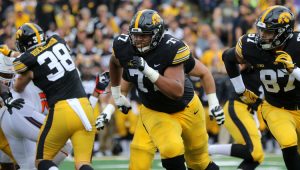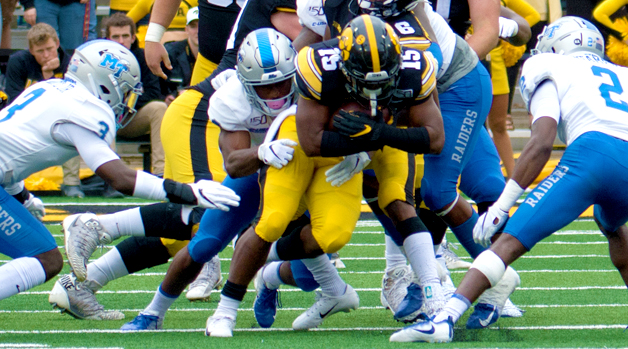Time for Iowa’s running game to finally live up to its reputation
By Pat Harty
IOWA CITY, Iowa – Will this finally be the season in which the Iowa running game actually lives up to its reputation?
You might be surprised how much it doesn’t happen.
While Iowa and Wisconsin often are lumped together as two Big Ten programs that excel behind vaunted rushing attacks, it’s really only true in the case of the Badgers.
Only once since 2010 has Wisconsin finished lower than third in the conference in rushing, while Iowa hasn’t finished ranked higher than fifth in the conference in rushing during that time, and has finished 10th or lower five times over the past decade, including 12th in 2012 and 2013.
Wisconsin has averaged at least 5.0 rushing yards per attempt as a team in eight of the last 10 seasons, while Iowa hasn’t averaged more than 4.5 rushing yards per attempt as a team during that time, and has averaged fewer than four yards per attempt as a team in four seasons since 2010.
Those are staggering differences, and yet, somehow Iowa continues to get credit for having a powerful rushing attack.
It is perhaps the most glaring misconception about the Iowa program heading into Kirk Ferentz’s 22nd season as head coach, which starts on Saturday at Purdue.
This misconception is probably partly due to Ferentz’s background as an offensive line coach, and because Iowa makes no secret that it wants to run the ball in a methodical fashion in order to control tempo and set the stage for play action.
Iowa pounded the University of Southern California 49-24 in the 2019 Holiday Bowl to cap a 10-3 season, and part of the offensive game plan included using the receivers more in running plays, and it was largely successful.
Receiver Tyrone Tracy Jr. scored Iowa’s first touchdown on a 23-yard run, while fellow receiver Ihmir Smith-Marsette scored on a 9-yard touchdown run.
But as team in the Holiday Bowl, Iowa only finished with 115 rushing yards on 35 carries, and averaged just 3.3 yards per carry.
The lack of a rushing attack didn’t impact the outcome, though, because USC was held to just 22 rushing yards on 18 carries.
But in many cases when Iowa averages fewer than four yards per rushing attempt as a team, it struggles to win.
“There’s more than one way to run the football,” said Iowa offensive coordinator Brian Ferentz. “There’s more than backs being involved in doing those things.
“But if you look at the games we have success in, and if you look at the games we win, we establish that running game and it gives us a chance to be successful, because ultimately, if you can run the football and stop the run, you can control the tempo of the game.”
Wisconsin has dominated Iowa over the past decade, and the Big Ten West Division overall, due mostly to its ability to control tempo with its overpowering running game.
It is now long overdue for Iowa for to live up to its reputation, and the pieces are certainly in place with a veteran offensive line that is ready to pave the way for dynamic sophomore running back Tyler Goodson to do his thing.

Fifth-year senior Alaric Jackson is entering his fourth season as Iowa’s starting left tackle, while Indiana graduate transfer Coy Cronk has started 40 games at tackle. Between them, Jackson and Cronk have over 70 starts.
Combine them with rising star Tyler Linderbaum at center, and with veteran guards Kyler Schott and Cole Banwart, and Iowa would seem to have what it takes to be successful on the ground.
Iowa also has a deep and talented group of receivers that defenses will have to account for, and that should only help the running game.
Other than the threat of injuries, there is no reason why Iowa shouldn’t average at least 150 to 175 rushing yards per game, and at least 4.5 yards per attempt as a team. That isn’t asking for a lot, especially given Iowa’s reputation as a run-oriented team.
Goodson has shown what he can do with room to run, and his two backups, seniors Mekhi Sargent and Ivory Kelly-Martin, also have excelled behind solid blocking.
Goodson became the first true freshman to lead Iowa in rushing last season with 638 yards and five touchdowns on 134 attempts.
The Georgia native is elusive and versatile, and capable of making big plays in space. He just needs a little room to get loose, and an effective game plan to keep defenses off balance.
Sophomore quarterback Spencer Petras will make his first career start on Saturday against Purdue, and his job will be much easier if the running game delivers.
It’s long over due for the running game to deliver, and for the Iowa offensive line to do its best impersonation of Wisconsin, even with different blocking schemes.
Iowa relies mostly on zone blocking, and that’s fine if it works.
But more times than not, it hasn’t worked, and that’s just hard to explain.
Wisconsin has certainly been blessed with outstanding running backs, but that still doesn’t explain, or justify, why it’s been so vastly superior to Iowa at running the football.
It’s time for Iowa to start narrowing the gap, and to live up to its reputation as a running team.
Iowa versus Wisconsin on the ground
A look back at how Iowa compares to Wisconsin from a rushing standpoint since 2010
Big Ten rank, attempts, yards, average-per carry, per-game average
2019
2. Wisconsin: 612, 3,263, 5.3, 233.1
10. Iowa: 453, 1,789, 3.9, 137.6
2018
- Wisconsin: 571, 3,554, 6.2, 273.4
10. Iowa, 488, 1,929, 4.0, 148.4
2017
2. Wisconsin, 629, 3,121, 5.0. 222.9
11. Iowa, 481, 1,810, 3.8, 139.2
2016
3. Wisconsin, 658, 2,843, 4.3, 203.1
8. Iowa, 502, 2,234, 4.5, 171.8
2015
10. Wisconsin, 512, 1,954, 3.8, 150.3
5. Iowa, 568, 2,544, 4.5, 181.7
2014
- Wisconson, 648, 4,482, 6.9, 320.1
7. Iowa, 514, 2,120, 4.1, 163.1
2013
2. Wisconsin, 557, 3,689, 6.6, 283.8
6. Iowa, 557, 2,339, 4.2, 179.9
2012
3. Wisconsin, 635, 3,309, 5.2, 236.4
12. Iowa, 404, 1,476, 3.7, 123.0
2011
- Wisconsin, 584, 3,194, 5.5, 235.6
12. Iowa, 454, 1,790, 3.9, 137.7
2010
2. Wisconsin, 584, 3,194, 5.5, 245.7
8. Iowa, 449, 1,929, 4.3, 148.4



